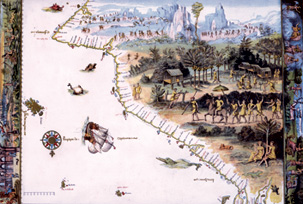|
Right: Abraham Ortelius, Typus Orbis Terrarum
.
Original on loan courtesy Dr N. Sjerp, Perth.
Western Australian Museum – Shipwreck Galleries.
This
world map from the famous Ortelius atlas Theartum Orbis
Terrarum was first printed in 1570.
As shown on this map,
the hypothetical southern landmass was named ‘Terra
Australis Nondum Cognita’. The
form of the ‘Southland’ was based on the travel
records of Marco Polo and Ludovico de Varthema, who travelled
widely in the early 16th century. |
|
Once the Portuguese entered the Indian
Ocean, Spanish, French, Dutch and English seafarers all tried
to locate the fabled Southland or Terra Australis Incognita.
Many thought they had found it.
Not realising that Dirk Hartog and his
compatriots had already encountered and mapped parts of Terra
Australis, Abel Tasman sailed from Batavia (now Jakarta)
to explore the Southland. He charted the coast, joining all the
previous Dutch discoveries into what he called New Holland.
For well over a century explorers still sought the Great South
Land including William Dampier and James Cook. Not to be out done
by their English rivals, French mariners such as Yves-Joseph de
Kerguelen-Tremarec and Louis de Saint Aloüarn also ventured
into the southern Indian Ocean looking for Terres
Australes.
It
was not until the voyages of Nicolas Baudin and Matthew Flinders
that the mystery was solved. Terra Australis
Incognita, the Great
South Land, was Australia.

First Map of Australia (1547)
1856
Published by Middle Hill Press, Worcestershire, 1856
Nicolas Vallard 1547
This is a copy of an original manuscript map of Java-Le-Grande,
first produced in 1547. One of fifteen maps of
the known world appearing in the Vallard Atlas, it
is from the ‘Dieppe School’ of French cartography.
This group of map makers used information from French
explorations and borrowed heavily on the work of other
European nations especially the Portuguese. North is
to the bottom.
Some suggest that this landmass depicts the eastern
coastline of Australia and was a result of the explorations
made by Cristóvão de Mendonça.
In 1521, King John III sent him to claim new lands
for Portugal before Ferdinand Magellan could do the
same for Spain.
Hailed in 1856 as ‘The First Map of Australia’,
it was seen as an affront to the achievements of Captain
James Cook RN, the theory being that it represents
Cape York (bottom right), New South Wales and Port
Phillip Bay (top right) has been hotly debated ever
since.
Original on loan courtesy of the Jock Clough
Collection. |


